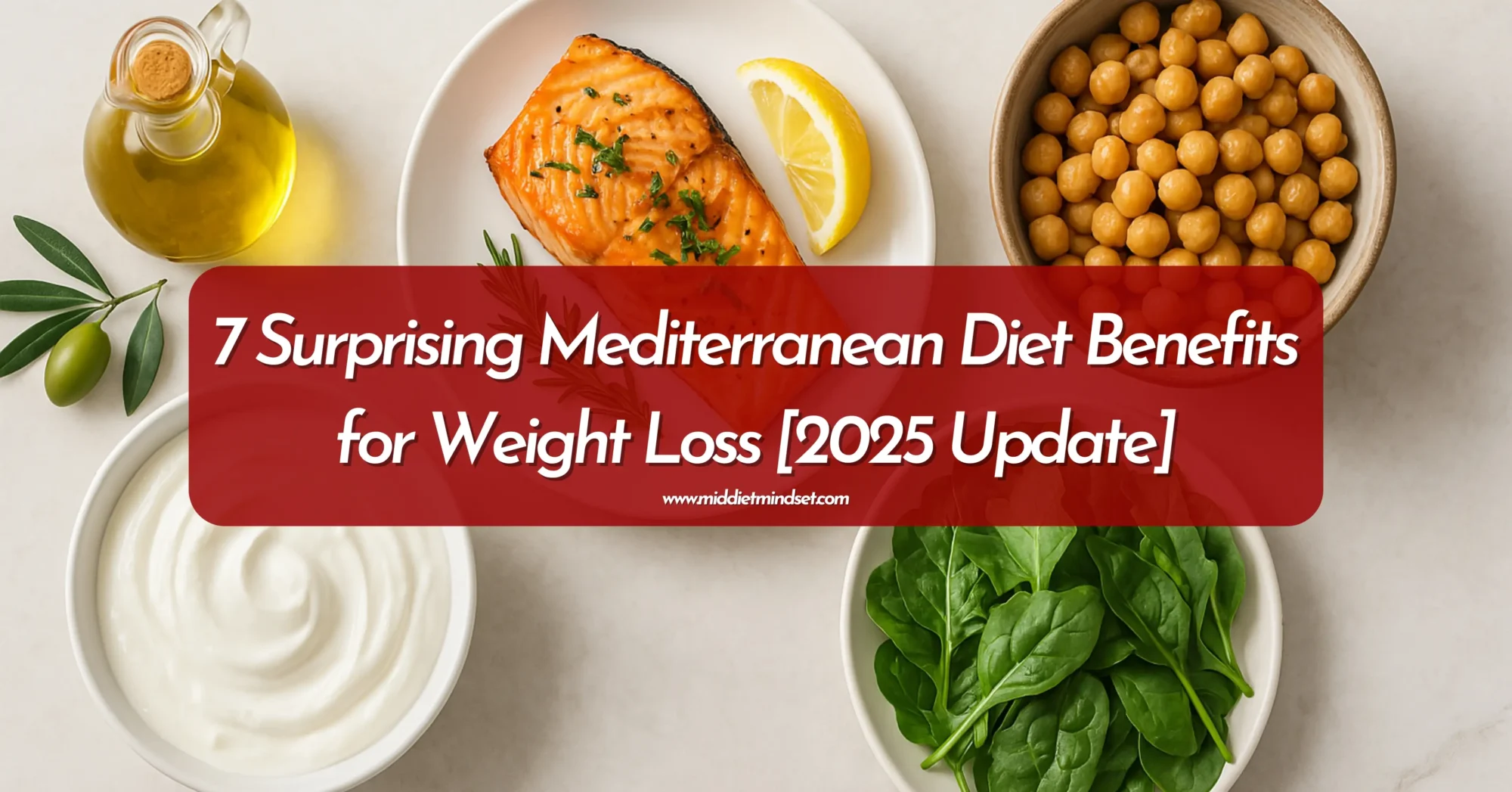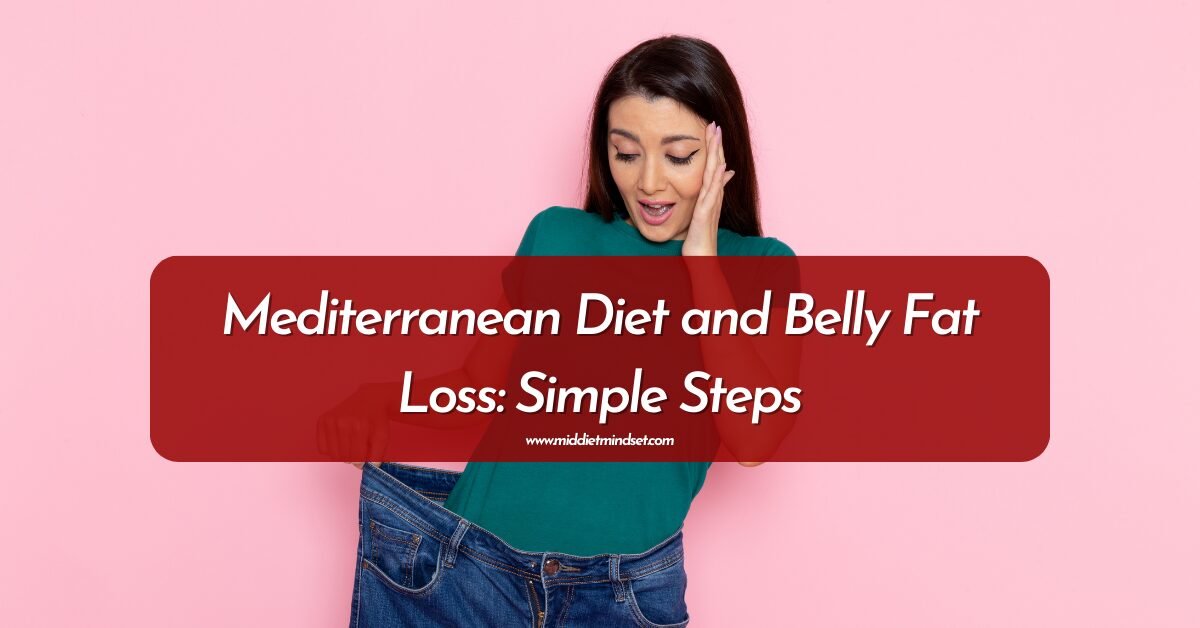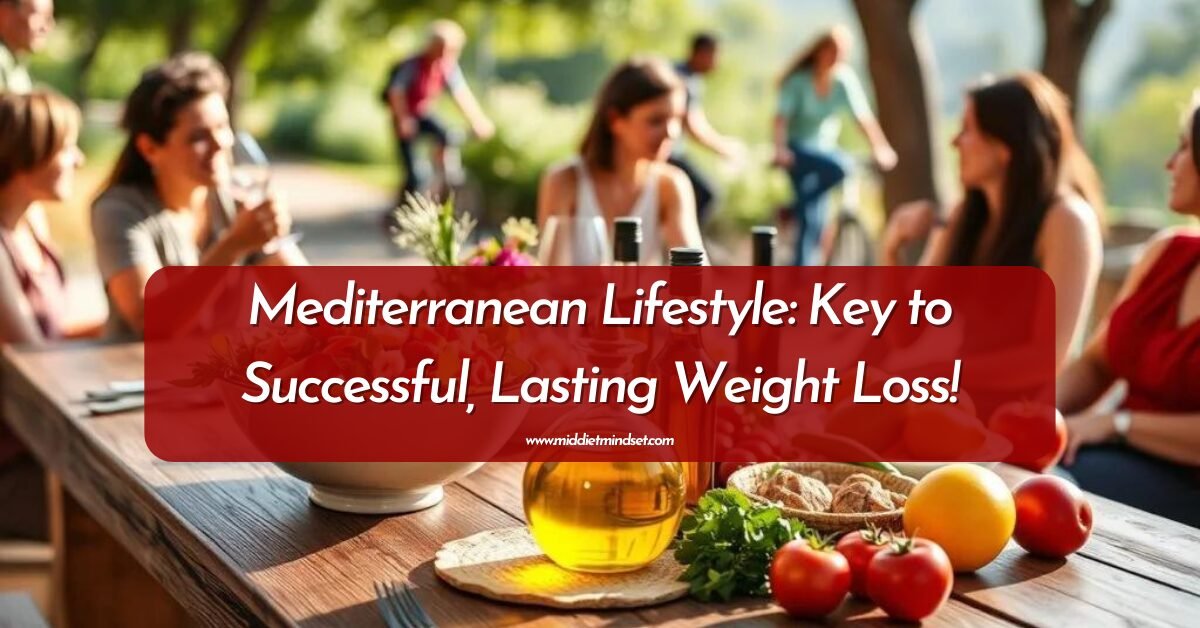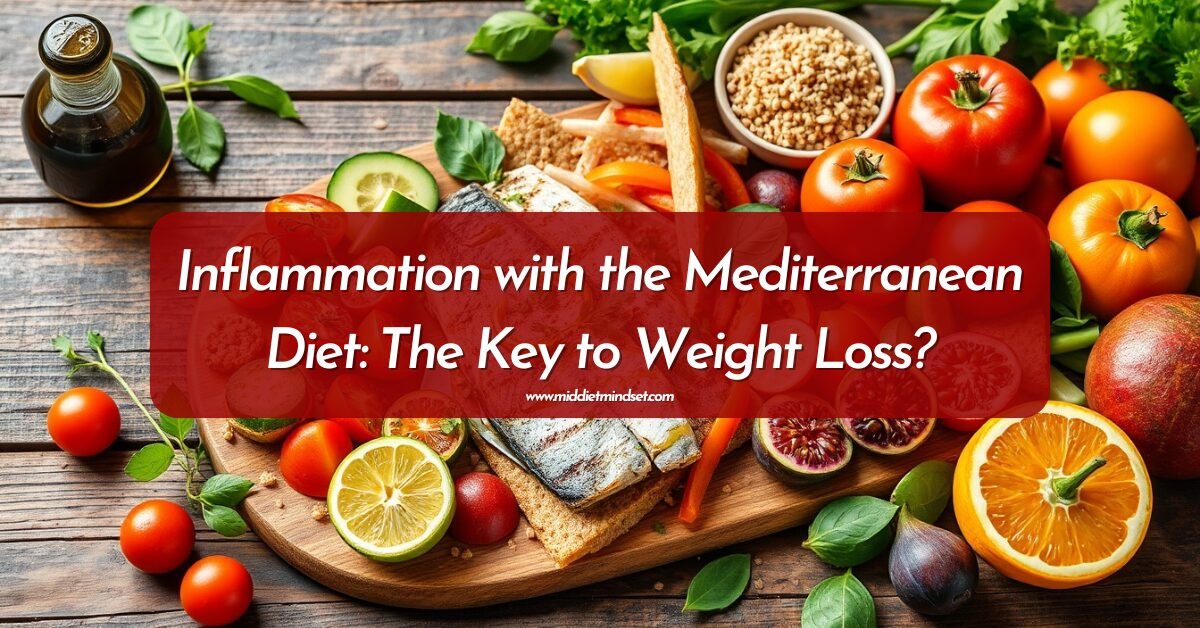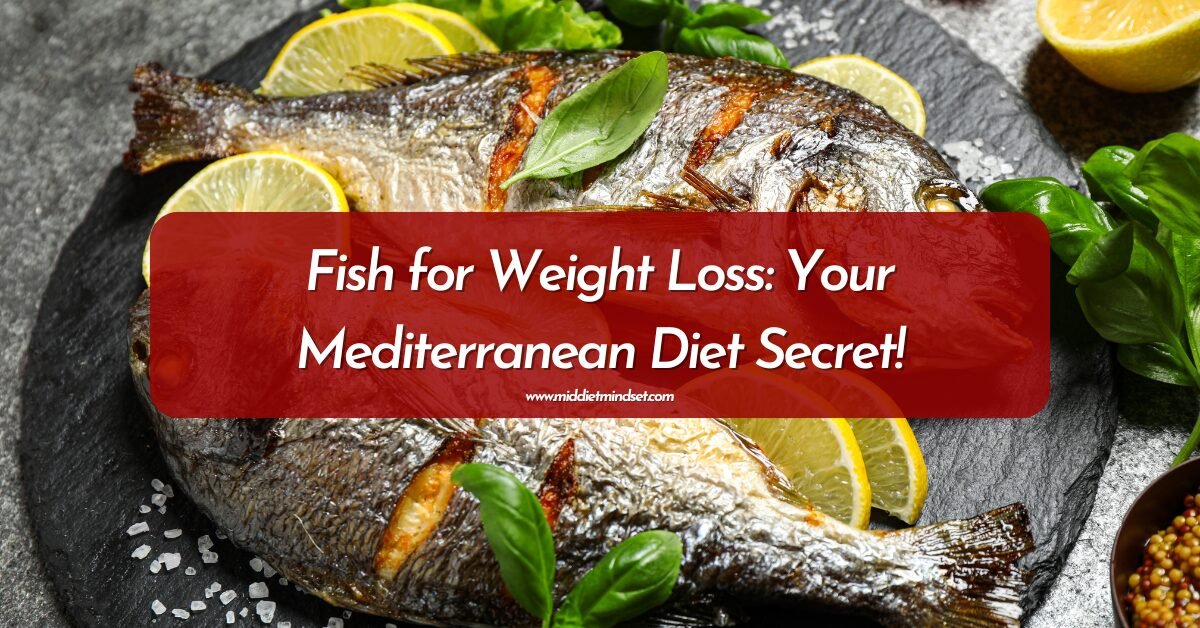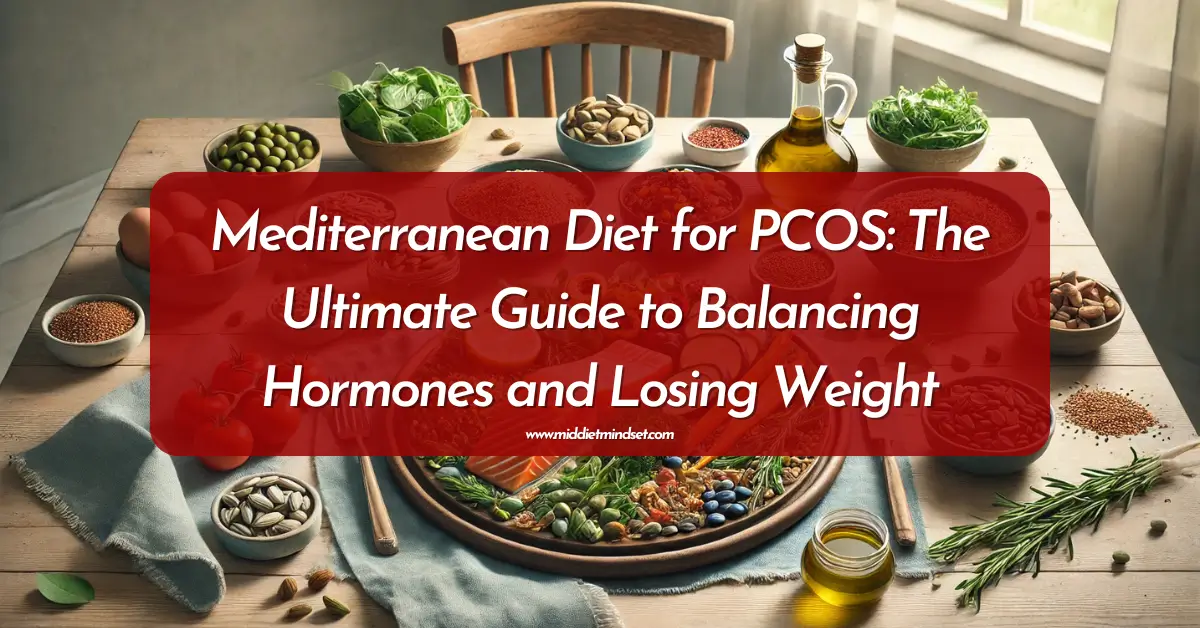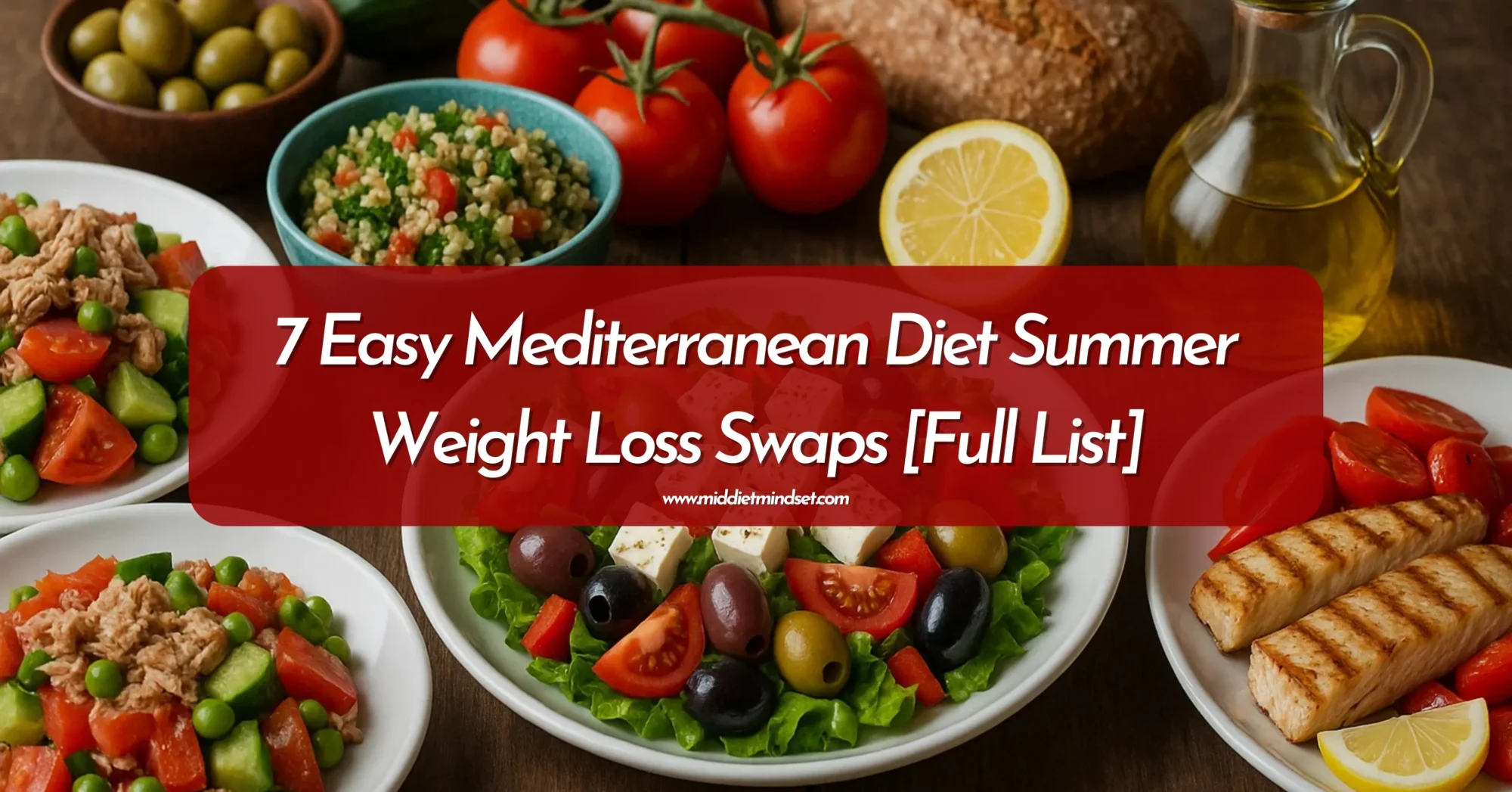Table of Contents
ToggleLet’s face it—Mediterranean diet fat-burning foods might just be the missing piece in your fat loss journey. You count calories, skip meals, and chase the newest fitness trend, only to see the scale barely budge. But what if the answer isn’t in eating less—but in eating smart?
As a registered dietitian, I’ve worked with people who tried every trick in the book. The one change that actually sticks? Switching to Mediterranean-style eating filled with real, satisfying foods that fire up your metabolism naturally.
I remember one of my clients, Leila, who came in feeling defeated. She’d tried keto, intermittent fasting—you name it. We swapped out her processed snacks for a few Mediterranean staples, and within three weeks, she wasn’t just losing weight—she had more energy, slept better, and finally felt in control of her cravings.
So in this article, I’ll break down five of the best Mediterranean diet fat-burning foods that actually work. Each one is backed by science, simple to add to your meals, and designed to help you burn fat without burning out.
Let’s dive in.

1. Extra Virgin Olive Oil: A Staple Among Mediterranean Diet Fat-Burning Foods
How It Helps Burn Fat
Extra virgin olive oil (EVOO) is widely known as a heart-healthy staple—and for good reason. Rich in monounsaturated fats, especially oleic acid, EVOO doesn’t just protect your heart—it also helps your body burn fat more efficiently.
It helps:
Boost fat oxidation: Oleic acid is readily used for energy and may support overall fat-burning when replacing other fats in the diet.
Improve insulin sensitivity: These fats help stabilize blood sugar levels and reduce the post-meal insulin spike that promotes fat storage.
Reduce inflammation that slows metabolism: EVOO’s polyphenols lower inflammation, helping rebalance fat-burning hormones like insulin and leptin.
Promote thermogenesis (your body’s fat-burning engine): Monounsaturated fats slightly increase calorie burning after eating due to their effects on metabolism and mitochondrial activity.
Unlike saturated fats, monounsaturated fats help your body favor burning over storing energy.
How to Add It to Your Diet
Drizzle it over salads, grilled veggies, or cooked grains
Mix with lemon and mustard for an easy homemade dressing
Add a spoonful to soups or dips just before serving
Aim for 1–2 tablespoons daily to enjoy the metabolic and cardiovascular benefits.
The Evidence Behind It
A 9-week double-blind clinical trial in Clinical Nutrition ESPEN examined the effects of extra virgin olive oil (EVOO) on women with excess body fat. All participants followed a calorie-restricted diet, but the only difference was the type of oil they consumed: one group had 25 mL of EVOO daily, while the control group consumed soybean oil. [1]
The EVOO group experienced significantly greater fat loss and improved blood pressure—despite not following the full Mediterranean diet. This highlights that EVOO alone offers powerful metabolic benefits, including improved body composition and a trend toward reduced inflammation.
In other words, EVOO on its own has proven benefits, and when it’s paired with other Mediterranean diet fat-burning foods, the impact is likely even greater—making it a foundational piece of the overall lifestyle.
Extra Tip: Cooking with EVOO Is Safe and Smart
Let’s clear this up once and for all: extra virgin olive oil is perfectly safe for cooking. A 2022 study showed that EVOO remains stable even when heated to 180°C (356°F) for up to two hours, retaining its antioxidant power and producing fewer harmful compounds than other oils. That makes it a smart choice for sautéing, roasting, and everyday cooking. [2]
Start with EVOO—but don’t stop there.
Extra virgin olive oil can improve fat loss and metabolic health even on its own. But when you combine it with other Mediterranean diet fat-burning foods, you unlock the full power of the Mediterranean lifestyle. One change at a time, one meal at a time—it all adds up.
2. Fatty Fish: Omega-3 Heroes of Mediterranean Diet Fat-Burning Foods
How It Helps Burn Fat
Fatty fish like salmon, sardines, and mackerel aren’t just good for your heart—they’re some of the most powerful Mediterranean diet fat-burning foods out there. Packed with omega-3 fatty acids, these fish support fat loss in multiple ways:
Reduce inflammation that blocks fat-burning: Omega-3s lower levels of chronic inflammation, helping your metabolism function more efficiently.
Improve insulin sensitivity: Better insulin response means your body stores less fat and uses more for energy.
Enhance satiety: Protein and healthy fats keep you fuller for longer, reducing overeating.
Support lean muscle mass: Omega-3s may improve muscle function and protect against muscle loss during weight loss.
In short? Fatty fish help you burn more fat, store less of it, and feel more satisfied—naturally.
How to Add It to Your Diet
- Grill or bake salmon with herbs, garlic, and lemon
- Toss canned sardines into a Mediterranean salad or spread on whole grain toast
- Add tuna to chickpea bowls with olive oil and arugula
Aim for 2–3 servings per week to soak up the metabolic benefits.
The Evidence Behind It
A 2022 scientific review took a deep dive into the benefits of eating fish—and the findings are pretty impressive. It showed that omega-3s from fatty fish like salmon and sardines can reduce triglycerides by up to 30%, enhance insulin sensitivity, and even boost fat oxidation by helping your cells burn energy more efficiently. What makes this even more important? Our bodies can’t make enough of these fats on their own—so eating fatty fish regularly isn’t just helpful, it’s essential if you want to tap into your body’s natural fat-burning potential. [3]
Extra Tip: Cold or Hot? Cook Smart for Full Benefits
For best results, use gentle cooking methods like baking or steaming. High-heat frying can degrade omega-3s. Also, add a squeeze of lemon juice post-cooking to enhance nutrient absorption—especially iron, which supports fat-burning.
3. Chickpeas: The Most Underrated Mediterranean Diet Fat-Burning Foods
How It Helps Burn Fat
Chickpeas—also known as garbanzo beans—are one of the most underrated Mediterranean diet fat-burning foods, especially when it comes to belly fat and satiety. Packed with fiber, plant-based protein, and resistant starch, chickpeas offer a three-in-one effect that supports sustainable fat loss. They help:
Increase fullness and reduce appetite: The soluble fiber in chickpeas slows digestion, helping you stay full longer and naturally eat less at your next meal.
Support blood sugar stability: Their low glycemic impact prevents energy crashes and curbs the insulin spikes that can promote fat storage.
Improve gut health: Resistant starch in chickpeas feeds beneficial gut bacteria, which play a growing role in regulating weight and fat metabolism.
Preserve lean muscle: Their plant-based protein helps support muscle retention during weight loss—crucial for maintaining a higher metabolic rate.
In short, they’re hearty, humble, and incredibly effective at keeping hunger and cravings in check.
How to Add It to Your Diet
- Blend into hummus for a creamy, high-fiber snack
- Add to grain bowls or leafy green salads
- Stir into veggie stews or Mediterranean soups like harira
- Roast with herbs and olive oil for a crunchy snack alternative
Aim for ½ to 1 cup of cooked chickpeas a few times a week to reap the benefits.
The Evidence Behind It
A 2017 study published in the Journal of Food Science and Technology found that women who ate chickpeas before a meal consumed up to 25% fewer calories at their next meal compared to those who had white bread. This effect was even stronger when the next meal came two hours later, showing just how well chickpeas keep you feeling full.
Thanks to their fiber and resistant starch, chickpeas may also support the release of satiety hormones like GLP-1 and PYY—the ones that help your body feel satisfied, regulate appetite, and support fat burning naturally. [4]
So not only are chickpeas delicious and versatile—they’re also powerful allies in your fat-loss routine.
Extra Tip: Soak Overnight for Better Digestion
Soaking dry chickpeas for 8–12 hours before cooking helps break down phytic acid—an antinutrient that can block mineral absorption. This simple step makes them easier to digest and helps your body absorb more iron, zinc, and magnesium to support fat-burning and metabolic health. [5]
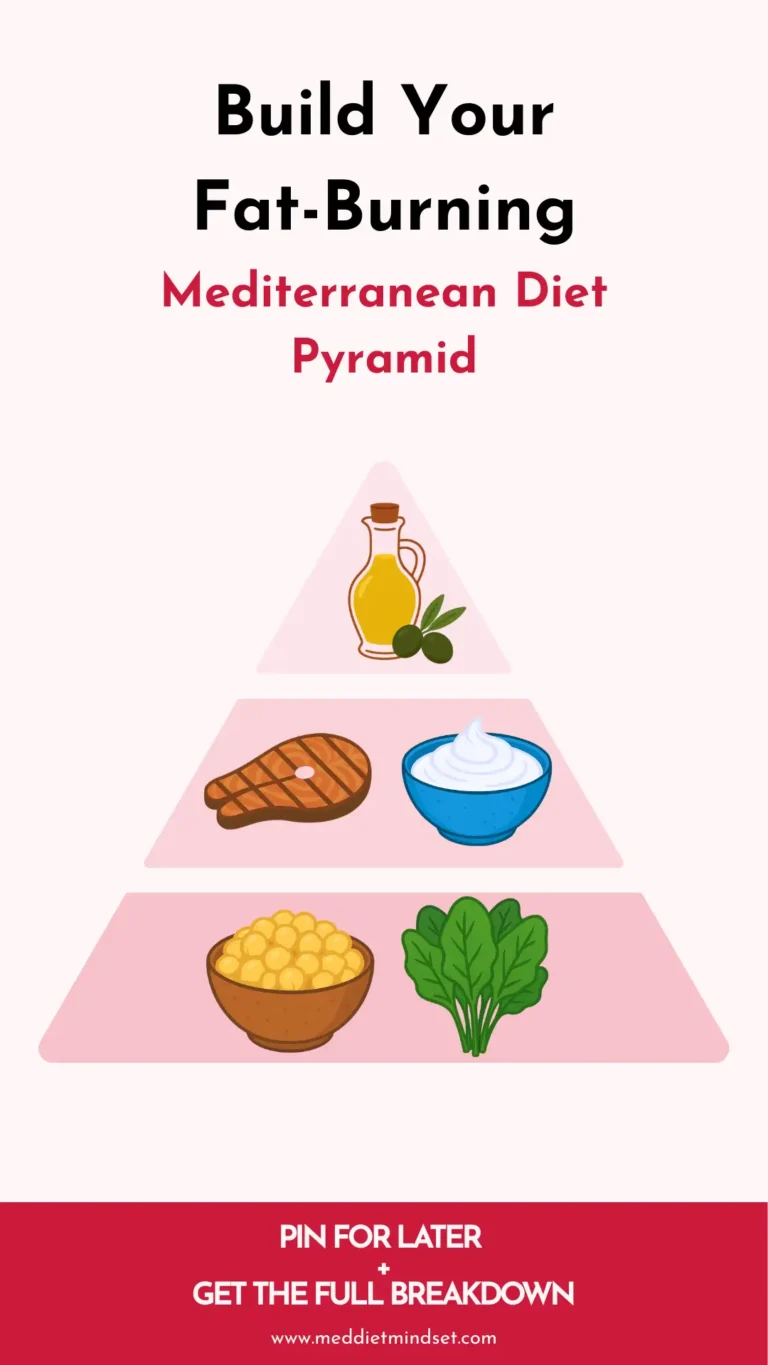
4. Greek Yogurt: One of the Best Mediterranean Diet Fat-Burning Foods
How It Helps Burn Fat
Greek yogurt is a standout among Mediterranean diet fat-burning foods—not just because it’s high in protein, but because it supports your metabolism from several angles. It helps:
Boost thermogenesis: The high protein content increases the number of calories your body burns during digestion—also known as the thermic effect of food.
Preserve lean muscle mass: Protein helps maintain muscle while losing fat—crucial for keeping your metabolism running efficiently.
Improve fat breakdown: Greek yogurt is rich in calcium, which plays a role in regulating fat storage and breakdown.
Support gut health: Its probiotics promote a healthy gut microbiome, which is increasingly linked to better weight regulation and reduced belly fat.
In short, Greek yogurt is a creamy, convenient way to burn more fat, feel full longer, and take care of your gut—all in one.
How to Add It to Your Diet
- Enjoy it with berries and chia seeds for breakfast
- Blend into smoothies for a post-workout boost
- Use it as a base for sauces, dressings, or savory dips like tzatziki
- Swap it for sour cream or mayonnaise in recipes
Stick with plain, unsweetened Greek yogurt to avoid added sugars and get the full fat-burning benefit.
The Evidence Behind It
A 12-week study published in Frontiers in Nutrition found that participants who added fat-free Greek yogurt to a reduced-calorie diet and workout routine lost more body fat and gained more lean muscle than those who had a lower-protein snack instead. [6]
The credit goes to Greek yogurt’s unique combo of high-quality protein and calcium—a duo that supports fat-burning, muscle repair, and appetite control. Plus, it’s incredibly satisfying, which makes it easier to stick to your goals without feeling restricted.
So if you’re looking for a snack that actually works with your body—not against it—Greek yogurt is a smart and science-backed choice.
Extra Tip: Post-Workout Fuel That Works
Having Greek yogurt within 30–60 minutes after exercise gives your body high-quality protein for muscle recovery and calcium to support both fat-burning and healthy muscle function. Add a piece of fruit for a balanced snack that fuels recovery, supports hydration, and keeps your metabolism humming.
5. Leafy Greens: Nutrient-Dense Mediterranean Diet Fat-Burning Foods That Keep You Full
How It Helps Burn Fat
Leafy greens like spinach, kale, arugula, and Swiss chard are among the most underrated Mediterranean diet fat-burning foods—and they do more than just “add color” to your plate. These low-calorie, nutrient-dense veggies create the ideal conditions for fat loss while keeping your meals satisfying and balanced. They help:
Increase meal volume without calories: You can eat large portions without going overboard on energy—perfect for feeling full while staying in a calorie deficit.
Support metabolism with key micronutrients: Leafy greens are rich in magnesium, folate, and iron—nutrients involved in energy production, hormone balance, and oxygen delivery.
Reduce cravings and appetite swings: Their fiber and water content slows digestion and supports stable blood sugar, keeping hunger in check.
Promote fat oxidation: Compounds like thylakoids in greens may help regulate fat digestion and stimulate natural fat-burning.
In short, they keep your plate full, your calories in check, and your metabolism happy.
How to Add It to Your Diet
- Start your lunch or dinner with a big leafy green salad
- Stir spinach or kale into soups, stews, and omelets
- Add arugula or chard to grain bowls or wraps
- Blend a handful into smoothies for a nutrient boost
Get in at least 1–2 handfuls a day—raw or lightly cooked—to get their full fat-burning benefits.
The Evidence Behind It
A study published in Public Health Nutrition looked at how vegetable intake affects body fat and insulin sensitivity—and the results were pretty impressive. Overweight participants who ate more nonstarchy vegetables like leafy greens had significantly less visceral fat, better insulin sensitivity, and lower liver fat compared to those who ate less. [7]
The researchers suggest that the bioactive compounds in leafy greens—like polyphenols and thylakoids—may help regulate fat metabolism, hunger hormones, and gut health, making these greens true metabolic allies.
So when you fill your plate with leafy greens, you’re not just loading up on fiber—you’re actively supporting your body’s natural fat-burning systems.
Extra Tip: Add a Fat Source to Unlock Nutrients
Leafy greens are full of fat-soluble nutrients like vitamins A, K, and E—but your body can’t absorb them well without a little healthy fat. Add olive oil, avocado, or a few olives to your greens to boost nutrient absorption and keep you feeling satisfied longer.
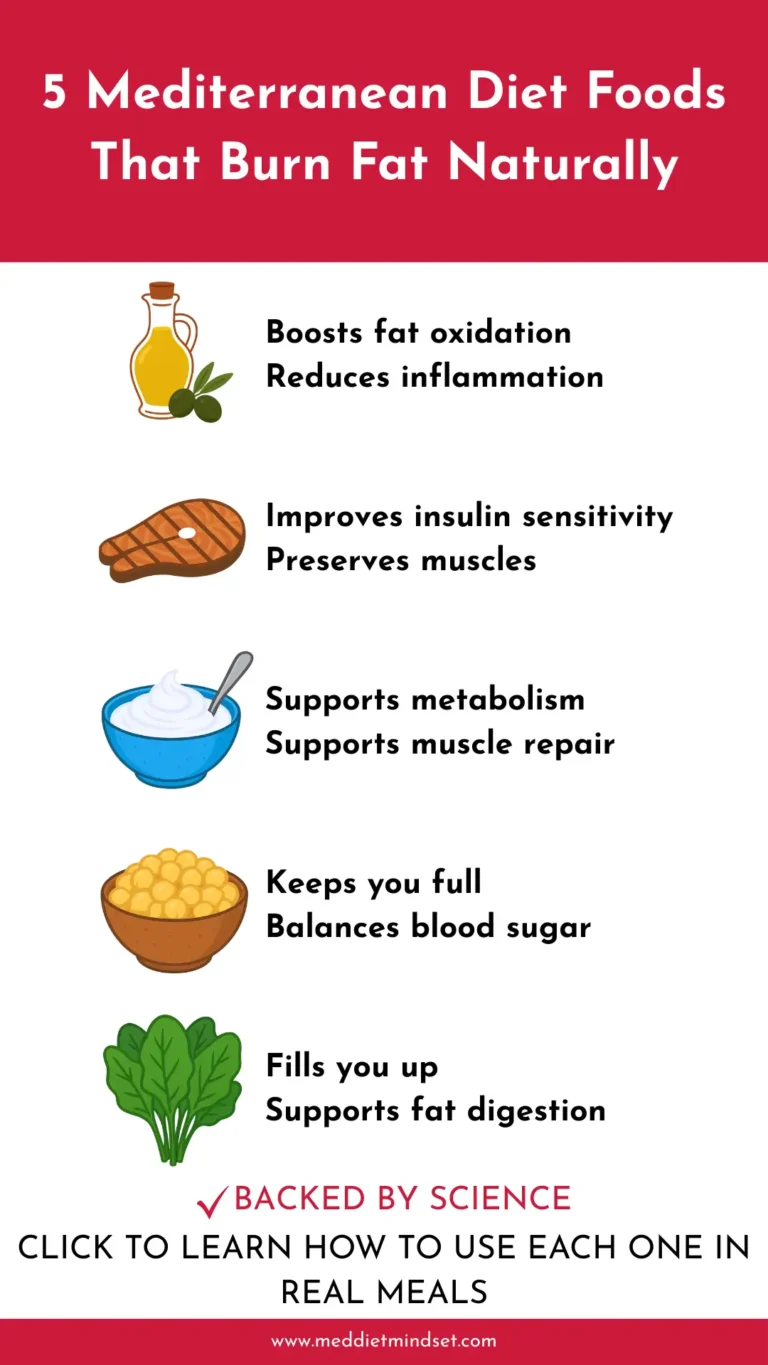
Final Thoughts: Why These Mediterranean Diet Fat-Burning Foods Actually Work
At the end of the day, sustainable fat loss isn’t about cutting out entire food groups or starving yourself—it’s about choosing foods that help your body do what it was designed to do: burn fat naturally.
By incorporating these Mediterranean diet fat-burning foods into your daily meals, you’re not only fueling your body—you’re retraining it to shed excess fat efficiently and enjoyably.
Here’s what we covered:
Why olive oil, fatty fish, chickpeas, Greek yogurt, and leafy greens support fat-burning.
How to use them in everyday meals.
The research proving they work.
- Plus, an extra tip for each food to help you get even more results with less guesswork.
Your turn:
Which one of these foods is already in your routine? And which are you excited to try next?
Want to take your transformation a step further? Check out this next post: Mediterranean Habits That Make Losing Weight a Breeze. It’s packed with simple lifestyle shifts that make a big difference.
F.A.Q.
Unlike trendy diets that often rely on severe restrictions, Mediterranean diet fat-burning foods are grounded in science and long-term sustainability. These foods work by naturally supporting the body’s metabolism, reducing chronic inflammation, and improving blood sugar balance—all key factors in healthy fat loss.
They’re also nutrient-dense and rich in fiber, healthy fats, and antioxidants, which help regulate appetite and reduce overeating. Instead of cutting out food groups, the Mediterranean approach encourages a balanced, enjoyable way of eating that makes fat loss feel less like a struggle and more like a lifestyle.
Yes, absolutely! One of the biggest misconceptions is that eating fat causes weight gain. In reality, the healthy fats found in Mediterranean diet fat-burning foods—like extra virgin olive oil, fatty fish, and nuts—actually help your body burn fat more efficiently.
These fats play a crucial role in hormone regulation, particularly insulin and leptin, which are responsible for fat storage and hunger cues. When consumed in moderation, these smart fats keep you full for longer, stabilize blood sugar, and prevent the overeating that often happens with low-fat, high-carb meals. The result? A more balanced metabolism and a steady, sustainable fat loss journey.
The timeline can vary from person to person, but many individuals start noticing benefits from Mediterranean diet fat-burning foods within the first 1–2 weeks. These early changes might include improved digestion, reduced bloating, more stable energy levels, and fewer cravings.
When these foods are combined with other Mediterranean habits like mindful movement, adequate hydration, and consistent meal timing, visible fat loss usually begins to appear around 3–6 weeks. Best of all, the results tend to be long-lasting because the Mediterranean diet is not a quick fix—it’s a way of life that supports both physical and metabolic health over time.

Nour is a registered dietitian, nutrition researcher, and founder of MedDietMindset. With a passion for evidence-based nutrition, she specializes in Mediterranean diet strategies, PCOS management, and sustainable weight loss. Nour is dedicated to transforming complex scientific research into clear, actionable guidance to support healthier, long-lasting lifestyle changes. Through her blog, she empowers readers to build habits that prioritize well-being, balance, and vitality.
